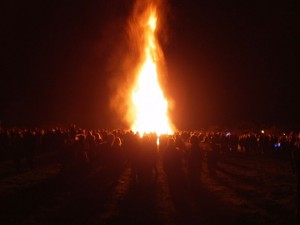Remember, Remember!
The fifth of November,
The Gunpowder treason and plot;
I know of no reason
Why the Gunpowder treason
Should ever be forgot!
Once upon a time, thirteen conspirators decided to blow up the House of Lords. Known as the Gunpowder Plot and foiled at its source, Catholic sympathizers wanted to kill James I and the Members of Parliament who made life difficult for English Catholics.
Guy Fawkes and his companions
Did the scheme contrive,
To blow the King and Parliament
All up alive.
Threescore barrels, laid below,
To prove old England’s overthrow.
Guy Fawkes wasn’t the ringleader, but he was the one placed in charge of 36 barrells of gunpowder in a celler under Westminster Palace. Born in the City of York, where he’s become a folk hero, Guy Fawkes was a handsome fellow with thick reddish brown hair, a flowing mustache and matching beard. Although I must admit I don’t care for the hat.

Conspirators set November 5 as their Day of Retribution. But then a few of them had second thoughts. What if they accidentally killed Members of Parliament who supported their cause? That would be a pity. An anonymous letter warned Lord Monteagle not to attend Parliament November 5. A loyal subject, and perhaps not wanting to be implicated, Lord Monteagle sent the note to King James. Troops broke into the cellar and found Guy Fawkes.

But, by God’s providence, him they catch,
With a dark lantern, lighting a match!
A stick and a stake
For King James’s sake!
If you won’t give me one,
I’ll take two,
The better for me,
And the worse for you.
King James was curious. But when he asked Guy Fawkes why he tried to commit such a reprehensible deed, the accused responded that a dangerous disease required a desperate remedy. In fact, Fawkes said, he’d hoped to blast the Scottish king back to Scotland.
The king was not amused and ordered various degrees of torture be applied until Fawkes revealed his co-conspirators. On January 31, 1606 Fawkes and those of his colleagues who’d been rounded up and given a quick trial were taken to the Old Palace Yard at Westminster where they were hanged, drawn and quartered.
A rope, a rope, to hang the Pope,
A penn’orth of cheese to choke him,
A pint of beer to wash it down,
And a jolly good fire to burn him.
Holloa, boys! holloa, boys! make the bells ring!
Holloa, boys! holloa boys! God save the King!
Hip, hip, hooor-r-r-ray!
The foiled plot is commemorated on November 5th, the day Parliament declared as a Day of Thanksgiving for the Joyful Deliverance of the King. The first bonfire was lit in London, but the custom spread throughout the land. Just the thing to stave off those early dark nights.

Guy Fawkes celebrations include an effigy of Guy Fawkes, called The Guy, which burns in the bonfire. Other effigies can be added. In modern times, Margaret Thatcher has been included.

For years I thought, as many people do, that the bonfires were a celebration of Guy Fawkes rather than the king’s escape. And perhaps there’s some truth to that. To this day, many Britons agree that “Guy Fawkes was the last man to enter Parliament with honest intentions.”
Acknowledgements:
Featured Image: Guy Fawkes Mask by Clipart Guru, Released to Public Domain, Wikimedia Commons.
The Fifth of November, an English Fok Verse, c.1870. Habing, B. (2006, November 3). The Fifth of November – English Folk Verse. Retrieved from http://www.potw.org/archive/potw405.html
Bonfire Night. Here.
David Herber, Guy Fawkes: A Biography. Britannia History. Here.

Sandra Wagner-Wright holds the doctoral degree in history and taught women’s and global history at the University of Hawai`i. Sandra travels for her research, most recently to Salem, Massachusetts, the setting of her new Salem Stories series. She also enjoys traveling for new experiences. Recent trips include Antarctica and a river cruise on the Rhine from Amsterdam to Basel.
Sandra particularly likes writing about strong women who make a difference. She lives in Hilo, Hawai`i with her family and writes a blog relating to history, travel, and the idiosyncrasies of life.

